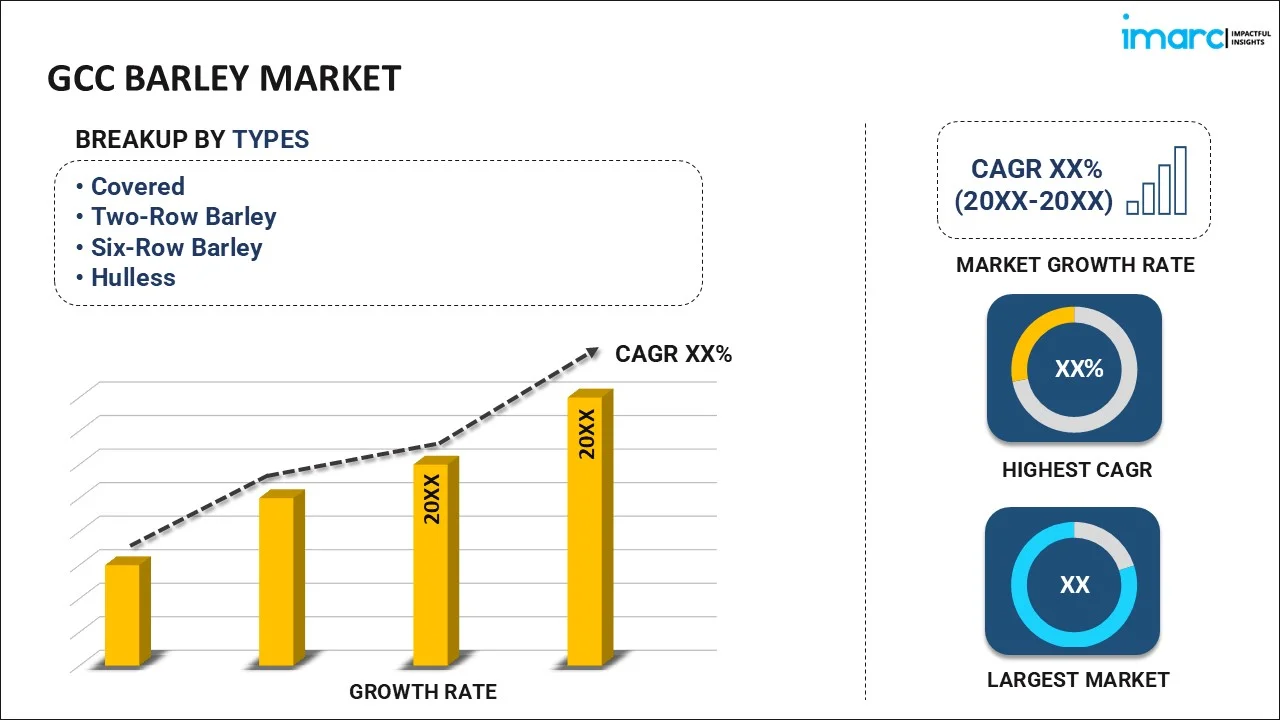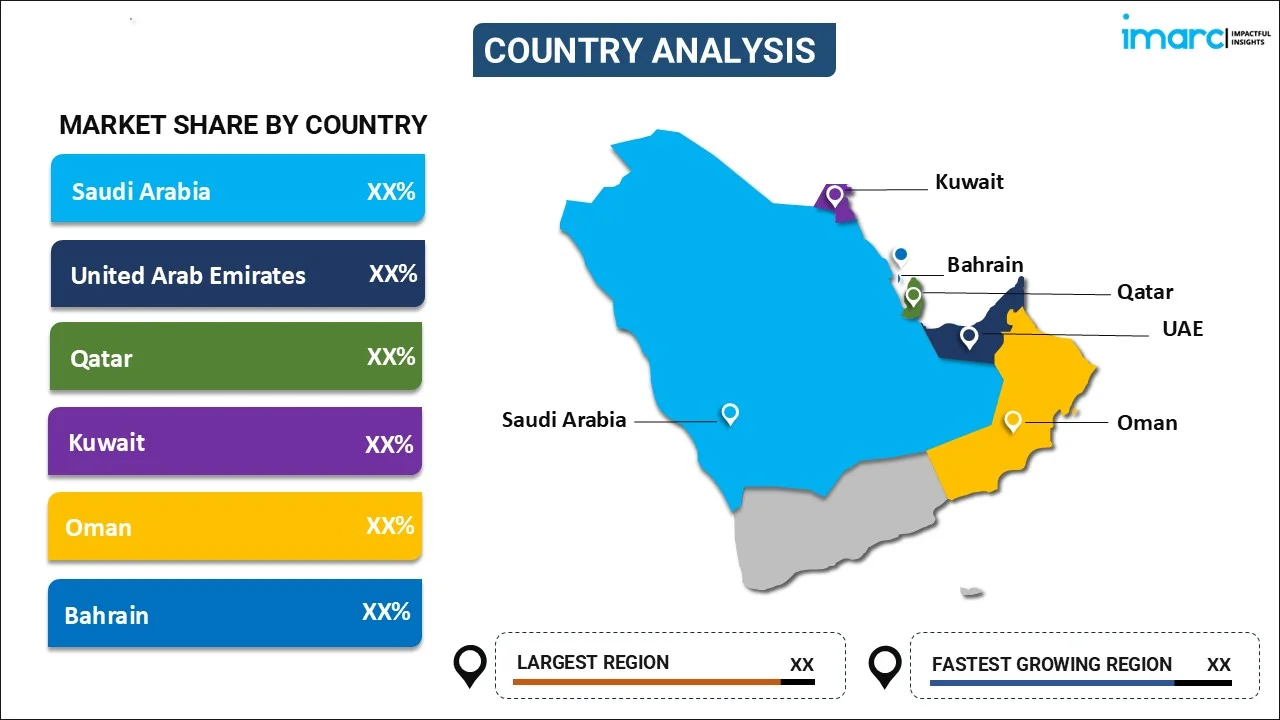
GCC Barley Market Report by Type (Covered, Two-Row Barley, Six-Row Barley, Hulless), Grade (Food Grade, Feed Grade, Malt Grade), Distribution Channel (Supermarkets and Hypermarkets, Departmental Stores, Specialty Stores, Online Stores), Industry Vertical (Food and Beverages, Pharmaceuticals, Seed Industry, Personal Care, Animal Feed, Nutraceuticals, and Others), and Country 2025-2033
Market Overview:
The GCC barley market size reached USD 461.9 Million in 2024. Looking forward, IMARC Group expects the market to reach USD 664.8 Million by 2033, exhibiting a growth rate (CAGR) of 4.1% during 2025-2033. The increasing demand for livestock feed, rising health consciousness among consumers, expansion of the agriculture and allied sectors and the food and beverage (F&B) industry, and the increasing investment in agricultural development represent some of the key factors driving the market.
|
Report Attribute
|
Key Statistics
|
|---|---|
|
Base Year
|
2024 |
|
Forecast Years
|
2025-2033
|
|
Historical Years
|
2019-2024
|
| Market Size in 2024 | USD 461.9 Million |
| Market Forecast in 2033 | USD 664.8 Million |
| Market Growth Rate (2025-2033) | 4.1% |
Barley is a versatile cereal grain that is among the oldest and most widely consumed grains in the world. It is grown in various climates across the world, with Russia, Germany, France, Canada, and Australia among the leading producers. Barley has a nutty flavor and chewy consistency. It is used in a wide range of culinary applications, depending on its processing. Whole grain barley, also known as hulled barley, retains its nutrient-rich bran and germ and can be used in stews, soups, salads, and as a side dish. Pearled barley, which is hulled and polished to remove the bran, is a popular ingredient in risotto-like dishes and soups. Barley is also commonly used in the production of beer and other alcoholic beverages due to its high fermentable sugar content. The grain is malted, which involves soaking it in water to allow germination, then drying it in hot air to halt the germination process. This malted barley is a crucial ingredient in beer and whiskey production. Nutritionally, barley is rich in fiber, vitamins, and minerals. It has various health benefits, including improved digestion, weight management, and heart health.
GCC Barley Market Trends:
The extensive use of barley as a feed grain for livestock in the GCC represents one of the key factors driving the growth of the barley market across the region. It is a substantial market for meat and dairy products, which is acting as a major growth-inducing factor. The demand for barley to feed the animals increases as the demand for these products increases, which is boosting the growth of the market. Barley is a crop that is well-suited to the harsh desert environments in the GCC, which is relatively drought-tolerant and able to grow in poor soils. This makes barley cultivation a viable agricultural activity in this region. The GCC region is heavily dependent on food imports, including barley, due to limited arable land and water resources. As global barley production increases, this region continues to be a significant market for barley imports. The market is also driven by the increasing health consciousness among GCC consumers who seek high-fiber, nutrient-rich foods. Barley, being a rich source of dietary fiber and nutrients, is gaining popularity. In addition to this, the use of barley in innovative food and beverage products, like barley bread, barley beverages, and barley-based breakfast cereals, is increasing in the region. Such product innovations attract health-conscious consumers and contribute to the growth of the market. Apart from this, governments in the GCC are investing in agricultural development and promoting local food production to reduce import dependency and achieve food security. Such initiatives provide a positive impetus to the growth of the market. Moreover, barley is a part of traditional Middle Eastern cuisine, which is used in dishes like soups and stews, thus creating a positive outlook for the market across the region.
GCC Barley Market Segmentation:
IMARC Group provides an analysis of the key trends in each segment of the GCC barley market report, along with forecasts at the regional and country levels for 2025-2033. Our report has categorized the market based on type, grade, distribution channel, and industry vertical.
Type Insights:

- Covered
- Two-Row Barley
- Six-Row Barley
- Hulless
The report has provided a detailed breakup and analysis of the market based on the type. This includes covered, two-row barley, six-row barley, and hulless.
Grade Insights:
- Food Grade
- Feed Grade
- Malt Grade
A detailed breakup and analysis of the market based on the grade has also been provided in the report. This includes food grade, feed grade, and malt grade.
Distribution Channel Insights:
- Supermarkets and Hypermarkets
- Departmental Stores
- Specialty Stores
- Online Stores
A detailed breakup and analysis of the market based on the distribution channel has also been provided in the report. This includes supermarkets and hypermarkets, departmental stores, specialty stores, and online stores.
Industry Vertical Insights:
- Food and Beverages
- Pharmaceuticals
- Seed Industry
- Personal Care
- Animal Feed
- Nutraceuticals
- Others
A detailed breakup and analysis of the market based on the industry vertical has also been provided in the report. This includes food and beverages, pharmaceuticals, seed industry, personal care, animal feed, nutraceuticals, and others.
Country Insights:

- Saudi Arabia
- UAE
- Qatar
- Oman
- Kuwait
- Bahrain
The report has also provided a comprehensive analysis of all the major regional markets, which include Saudi Arabia, the UAE, Qatar, Oman, Kuwait, and Bahrain.
Competitive Landscape:
The report has also provided a comprehensive analysis of the competitive landscape in the GCC barley market. Competitive analysis such as market structure, key player positioning, top winning strategies, competitive dashboard, and company evaluation quadrant has been covered in the report. Also, detailed profiles of all major companies have been provided.
GCC Barley Market Report Coverage:
| Report Features | Details |
|---|---|
| Base Year of the Analysis | 2024 |
| Historical Period | 2019-2024 |
| Forecast Period | 2025-2033 |
| Units | Million USD |
| Scope of the Report | Exploration of Historical and Forecast Trends, Industry Catalysts and Challenges, Segment-Wise Historical and Predictive Market Assessment:
|
| Types Covered | Covered, Two-Row Barley, Six-Row Barley, Hulless |
| Grades Covered | Food Grade, Feed Grade, Malt Grade |
| Distribution Channels Covered | Supermarkets and Hypermarkets, Departmental Stores, Specialty Stores, Online Stores |
| Industry Verticals Covered | Food and Beverages, Pharmaceuticals, Seed Industry, Personal Care, Animal Feed, Nutraceuticals, Others |
| Countries Covered | Saudi Arabia, UAE, Qatar, Bahrain, Kuwait, Oman |
| Customization Scope | 10% Free Customization |
| Post-Sale Analyst Support | 10-12 Weeks |
| Delivery Format | PDF and Excel through Email (We can also provide the editable version of the report in PPT/Word format on special request) |
Key Questions Answered in This Report:
- How has the GCC barley market performed so far and how will it perform in the coming years?
- What has been the impact of COVID-19 on the GCC barley market?
- What is the breakup of the GCC barley market on the basis of type?
- What is the breakup of the GCC barley market on the basis of grade?
- What is the breakup of the GCC barley market on the basis of distribution channel?
- What is the breakup of the GCC barley market on the basis of industry vertical?
- What are the various stages in the value chain of the GCC barley market?
- What are the key driving factors and challenges in the GCC barley market?
- What is the structure of the GCC barley market and who are the key players?
- What is the degree of competition in the GCC barley market?
Key Benefits for Stakeholders:
- IMARC’s report offers a comprehensive quantitative analysis of various market segments, historical and current market trends, market forecasts, and dynamics of the GCC barley market from 2019-2033.
- The research study provides the latest information on the market drivers, challenges, and opportunities in the GCC barley market.
- Porter's five forces analysis assist stakeholders in assessing the impact of new entrants, competitive rivalry, supplier power, buyer power, and the threat of substitution. It helps stakeholders to analyze the level of competition within the GCC barley industry and its attractiveness.
- Competitive landscape allows stakeholders to understand their competitive environment and provides an insight into the current positions of key players in the market.
Need more help?
- Speak to our experienced analysts for insights on the current market scenarios.
- Include additional segments and countries to customize the report as per your requirement.
- Gain an unparalleled competitive advantage in your domain by understanding how to utilize the report and positively impacting your operations and revenue.
- For further assistance, please connect with our analysts.
 Inquire Before Buying
Inquire Before Buying
 Speak to an Analyst
Speak to an Analyst
 Request Brochure
Request Brochure
 Request Customization
Request Customization




.webp)




.webp)












